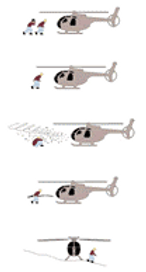Technical Article
Working Safely Around Aircraft
Now that the summer is upon us, many fire fighters will be more involved in working with aircraft as part of their operational activities. This may involve working along Rural Fire crews at vegetation fires or assisting with loading patients onto medical rescue aircraft.
Working safely around aircraft is paramount. It is the responsibility of you and your crew to ensure safe practices are maintained at all times. Important safety rules must be followed at all times regardless of whether you are working with helicopters or fixed wing aircraft. Your safety as well as the safety of the aircrew depend on these basic rules being strictly adhered to.
HELICOPTER SAFETY
When working with helicopters some important things to remember –
-
Stay in the pilots field of view at all times and only approach the helicopter when the pilot indicates that it is safe to do so.
-
Stay away from spinning main and tail rotor blades. They are not usually visible. Before you move always identify the safe pathway to and from the helicopter. It is very easy to become so engrossed in what you are doing and forget the proximity of spinning blades.
-
Stand outside the main rotor disc arc within the pilot’s view and enter in a crouched position when the pilot signals for you to move forward.
-
Be aware that on windy days, a slow moving main rotor can easily tilt downwards. In certain conditions for some models of helicopter, this can be as low as chest height!
-
Do not stand directly in front of and close to the helicopter during take off as it will need to achieve forward speed to ascend.
-
Be aware of ground slope and irregularities. Always approach and depart from the downslope side to ensure you have maximum clearance.
-
Ensure that all helmets are secured under the chin with a chin strap or carried securely under the arm. Never wear baseball type or similar soft cloth caps. Also ensure that all nearby equipment is secure.
-
Stretchers, tools and long objects must all be carried in the horizontal position and at waist height or lower. Use two people to carry long objects.
-
If boarding, do so carefully and gently. A sudden increase in weight caused by you “jumping in” can be enough to upset the stability of the helicopter. Only exit when instructed to by the pilot.
FIXED WING AIRCRAFT SAFETY
When working with fixed wing aircraft remember that the “safe zone” is the reverse of that for a helicopter. The recommended safe area is an approach from behind the wings and well clear of any propellers.
-
As with helicopters, always stay in the pilots view and only approach into the safe area when the pilot indicates that it is safe to do so.
-
Always be aware of propellers particularly when the plane is idling during warm up and brief stops to load or unload.
-
Never stand directly behind engine exhausts, with engines running extreme temperatures can be expelled over 12 metres behind the aircraft
-
Do not handle control surfaces such as ailerons, elevators, rudders, flaps or trim tabs.
-
Do not touch the pitot tubes as they are easily bent and can be very hot.
-
Ensure all gear and helmets are secured if you are going to be working near the aircraft while it is idling.
Some final thoughts. Appoint a safety officer and always limit the number of people working in and around aircraft to the very minimum required to complete the task safely. Always wear protective overalls, goggles, ear protectors and a secured helmet. A moment’s inattention when working around aircraft can have serious consequences.


